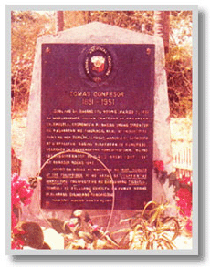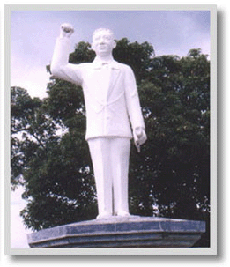|
 INTERESTING PLACES
INTERESTING PLACES |
|
Cabatuan Church
Neoclassical in style, the church of San Nicolas de Tolentino, patron saint
of Cabatuan, was built in 1834, replacing the temporary ones constructed by
earlier priests. It was Rev. Fr. Ramon Alquizar, an Augustinian, who
initiated the building the church. Every side of the church is a facade in
itself. Its walls are overlaid with red bricks. |
 |
|
The Cabatuan church
|
|
Before World War II, there was
a spacious rectory or convento at the right side of the church. It was
however burned by the guerillas in 1942 as part of their scorched earth
strategy. In 1943, it was demolished by the Japanese Imperial Army and its
bricks were used as overlay for the Tiring Landing Field. On Jan. 25, 1948,
the church was partly destroyed by an earthquake that rocked the island of
Panay.
The central structure of the
church is in the shape of the cross which is about 50 meters long and about
20 meters wide, with its walls about a meter and a half thick. Its facade is
decorated with the pope's tiara flanked by the Augustinian symbol of the
transfixed heart capped by the bishop's hat surrounded by a cord. The upper
part of the walls have 19 circular windows with multicolored glass panes.
See
more photos of the church
|
|
 |
Cabatuan
Cemetery
This is the only extant
Spanish cemetery in the Philippines that is a perfect square. With an area
of four hectares, it was completed in 1894 after a nine-year construction
period. The construction was done under forced labor, with its walls and
chapel made of selected stones from the mountains of Leon.
The cemetery is Roman in style
and enclosed on all four sides by solid limestones base with
artistically-designed steel railings. At the center of the cemetery stands a
capilla with three entrance archways.
The capilla is still in
good condition with its stone carvings still visible. Inscribed on a stone
tablet at its main entrance is the line: "Hatagi siya O Guinoo sang
capahuayan nga dayon (Eternal rest grant unto him, Oh Lord)." |
|
The entrance archway (top)
of the Cabatuan cemetery and its capilla at the center (bottom). |
Tomas Confesor Marker
and Monument |
|
 |
 |
|
In 1974,
the National Historical Commission erected a marker in Barangay Leong at the
very spot where the house where Tomas Confesor was born on March 2, 1891
used to stand.
The statue
of Tomas Confesor was constructed in 1991 at the northern portion of the
town plaza to commemorate the 100th anniversary of his birth. At the base of the statue lies the mortal remains of the famous
guerilla leader during World War II and his wife, the former Rosalina Grecia
of Jaro, Iloilo City.
Visit
the Tomas Confesor Digital Library
|
|
Pamul-ogan Hill and Cross
Found in Barangay Pamul-ogan,
about 4 kilometers from the poblacion, is a hill where the seed of
Christianity was said to have been planted by the Spaniards. A huge cross
made of hard thick molave used to stand at its summit,
although
what remains of it now is only its base. Carved at the base of the cross is
"1732", the year of the founding of Cabatuan. The date is less distinct but
clearly visible. |
 |
|
The cross at summit of
Pamul-ogan Hill |
|
Residents
blamed the babaylans for the loss of the cross who would scrape it every
Good Friday because they believed it can give them supernatural powers. The
scraped portions were used to mix with some medicinal herbs to make the
concoction more effective. It became shorter not because of its exposure to
the elements but because of this superstitious practice. Old residents of the town
recall that the cross was more than four meters high.
|
|
 |
Baluarte Hill
Popularly known as Balic Hill,
thousands of devotees make their pilgrimage here every Good Friday by
participating in the three-hour via crucis that starts at the church at
6 a.m. This is the final destination of the reenactment of the passion of
Jesus Christ.
From the summit of the hill,
one could see the silhouette of Guimaras and the strait of Iloilo to the
east, and the blue-green mountains of Madjaas, Panay's hightest peak, and
some rooftops in neighboring Maasin to the west
|
|
The cross at the summit of
Baluarte Hill |
|
|
The Tree of Bondage
This calachuchi tree was
said to be where the Spanish soldiers tied and punish with lashes erring
Filipinos who were conscripted to forced labor during the construction of the Cabatuan church. Standing in front of the municipal hall, it is surrounded
by steel railings and a marker facing the road. The tree has been there
since the early 1800s. |
 |
|
The Tree of Bondage |
Tiring Landing Field
Now a vast area of rice
paddies, it used to be site of an airstrip of the Japanese Imperial Army.
It stretches up to the boundaries of towns of San Miguel to the southwest
and Santa Barbara to the east. Following the defeat of the Japanese, the
American liberation forces turned the landing field into a general
concentration camp of Japanese prisoners until they were all hauled by
trucks to Iloilo City.
The Department of
Transportation and Communication (DOTC) is now eyeing the area to be the
site of the Iloilo International Airport.
Japanese Fortification
This concrete structure was
built by the Japanese Imperial Army in a hill in Barangay Tabucan, it is 20
feet in height and 9 feet in diameter. It served as a lookout post for
Japanese soldiers guarding the road and approach of the Tiring Landing
Field. Its walls are still intact until today.
|
|
 EVENTS and FESTIVALS
EVENTS and FESTIVALS
|
|
Via Crucis sa Balic
Good Friday in Cabatuan is not
complete without the Via Crucis to the Baluarte Hill, otherwise known as the
Balic Hill. Every year, thousands of devotees make their pilgrimage every
Good Friday by participating in the three-hour Via Crucis that starts at the
church at 6 a.m. The procession's winding route is about three kilometers
long, crossing the Balic Bridge, and ends at the summit of the hill. As the
first pack of devotees reach the cross at the top of the hill, the tail of
the procession can still be seen from the outskirts of the town, proof of
the magnitude of participants in this religious event.
After the Via Crucis,
residents of Barangay Balic serve devotees with ibus, alupi, puto, conchinta
and other variance of rice cakes, native chocolate and ripe mango. The
practice started in 1952 when Patricio Confesor, owner of the property when
the hill stands, hired a bulldozer to cut an upward winding road which in
short distance below look like a ribbon on top of a semi-circular vertical
cliff.
|
|
Pasyon Singing and Kapiya
Another feature of Lent in
Cabatuan is the pasyon singing and kapiya contests, a townwide
undertaking participated in by 14 groups from 68 barangays. Preparations for
the contest last for a week. The kapiyas are makeshift altars with a
tableau of colorful life-size figures made of indigenous materials. These
are put up in 14 street corners, each representing one station of the cross.
It is in these kapiyas
where the afternoon Via Crucis stops for meditation. Men, women and children
in barong tagalog and baro't saya sing the pasyon in
the kapiyas, starting at dusk. The pasyon relates the story of the
suffering and death of Jesus Christ in a song chanted for two hours by
choirs composed of 15 to 40 members. During the Via Crucis, life-size images
of saints kept by the town's elite families join the procession. It is
followed by the hadu, or kissing the wounds of the Cricufied Christ at the
church which lasts until the wee hours of Black Saturday.
|
|
Dampug
Held at dawn of Easter Sunday,
this is the announcement by an angel, portrayed by a child, of the
resurrection of Jesus Christ. The announcement is made after the images of
the Mother Mary and the Resurrected Christ, each coming from opposite
directions, meet and side by side, lead the procession back to the church.
The declaration of the angel is held in a well-decorated stage complete with
sound and visual effects. This is equivalent to the Salubong in the Luzon
area.
|
|
Hirinugyaw
This is Cabatuan's version
of Iloilo City's Dinagyang and Kalibo's Atiatihan. It showcases
various facets of the unique culture and traditions of Cabatuan. It
was started in 1995 to find Cabatuan a place in the tourism map and
to highlight the townspeople's ability to transform traditional
ceremonies into modernized dances. Courtship and marriage rituals as
well as farm dances of the olden days were performed to the music of the
modern times. |
 |
|
Hirinugyaw dancers |
|
See
more Hirinugyaw photos |
|
 DELICACIES
DELICACIES |
|

|
|
Tinuom
Marinated native chicken
with quartered potatoes seasoned with onions, ginger, tomato and lemon
grass (tanglad), and wrapped in banana leaves. It is served with broth
that accumulates inside its wrapping following a heavy steaming. A
serving costs P30 at the Leah's Tinuom, a popular weekend destination
for city residents and those from neighboring towns. The place is found at the right side of the Cabatuan
public market.
|
|
|
Binakol
Visit your
friends in Cabatuan and for sure they will serve you with binakol.
The fiesta is also not complete without this. Binakol is chicken cooked in
a pot or bamboo node, and mixed with potatoes, ginger, onions,
tomatoes, lemon grass, bay leaf and peppercorns. Boiled to
perfection, its broth perks up your appetite once blended in rice. |
 |
|
Chicken binakol |
|
|
KBL/KMU
These are not political
acronyms but another favorite during fiestas in Cabatuan. KBL is kadyos,
baboy and langka, while KMU is kadyos, manok and ubad. The preparation
for the former consists of pork, kadyos (pigeon peas or black-eyed
beans) and green jackfruit, and for the latter, pork is substituted by
chicken and jackfruit is substituted by ubad (the core of the banana
trunk). Even on ordinary days, Cabatuananons love to serve these dishes
because they are not only satisfying but the ingredients are affordable.
|
|
Huwad-huwad
Spending an afternoon in Cabatuan is not complete without hearing a
vendor cry: "Huwwwwaaaad huwwwaaaad!" This snack consists of
glutinous rice mixed with grated coconut and sugar, molded into rolls,
steamed and wrapped in banana leaves.
Linupak nga Saging/Linupak
nga Balinghoy
One memory that a visitor
to the barangays in Cabatuan will surely cherish is the experience of
preparing linupak. With the lusong (wooden pestle) and the bayo (wooden
mortar), boiled bananas (saging) or
cassavas (balinghoy) are pounded to blend with brown sugar until they
produce a pudding. It is a satisfying snack for the kids and adults.
|
 |
Ibus
Let's face it! Some of those who join the Via Crucis to Balic are
not really meditating on the passion of Jesus Christ but they simply
to eat ibus after the procession when they drop by a friend's house.
This snack is made of glutinous
rice cooked inside strips of coconut leaves formed into a tube and
tied at the end. They are best served with sugar , ripe mango and
native chocolate. |
|
Ibus |
|
|
Linugaw/Ginat-an
A favorite during the
fiesta minatay (All Soul's Day), this dish is made of boiled rice flour with
sago, sweet potato (camote), cubed boiled banana, taro and other root
crops, and rice balls, stirred with sugar and coconut cream. This is
also served during birthdays, mahjong sessions, village meetings and
other ordinary occasions.
|

|
|
Linugaw |
|
|